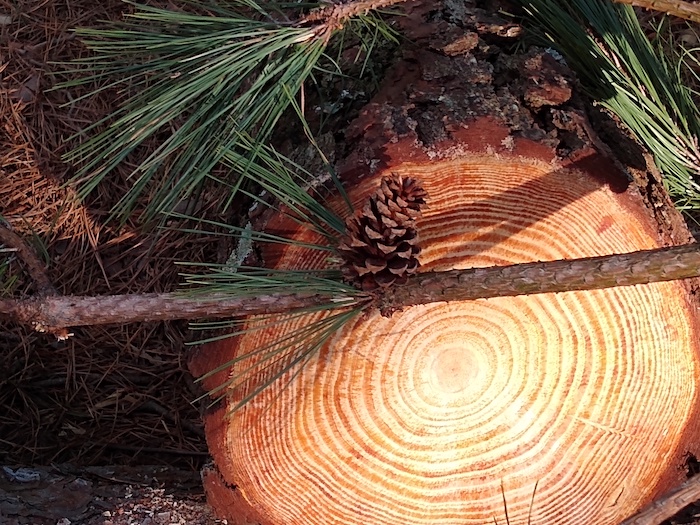Science at Home! Tree Rings
For immediate release ‐ May 14, 2020
Contact: Jessica Wackes, 919.707.9850. Images available upon request
Are you looking for something to do to keep your brain active and engaged? We’re here to help with Science at Home!
This week, the Museum’s own Bob Alderink walks us through the fascinating details we can learn by studying a tree’s growth rings. You can always visit the Museum’s Science at Home page for additional resources.
The Experiment

“This Loblolly Pine was growing dangerously close to the house and had to be cut down. On the bright side, it provides us with a unique opportunity to look at how a tree grows and how the tree’s growth rings can tell us about past weather events and climate change.

“Here are two types of growth rings: Spring and Summer growth rings. Each year the tree is alive, it adds a pair of these light and dark rings, creating a record of its age and contributing to its width. As the years progress, these rings also record the tree’s growing conditions over the course of its life, including periods of drought, excessive rain and any injuries the tree may have sustained.
The Spring growth ring is lighter in color as the cell walls are thinner, signifying rapid growth. In Spring, there is generally more water available to the tree and, importantly, there are fewer insect pests around to munch on these tender new cells.
In Summer, there is plenty of sunlight and in some areas plenty of rain. However, temperatures are much higher, so a larger percentage of the rain that does fall, tends to evaporate before the tree can fully utilize it. This time of year, insects tend to be at their peak, causing additional stress on the tree. The tree responds by putting less energy into growth and more into protection by growing thicker, tougher cell walls.

“Tree rings paint a story of its history. If weather conditions are favorable, growth rings tend to be wide. During periods of stress, such as a prolonged drought, growth rings are often thinner than the years before and after. In this photo, the arrow points to a thin Spring growth ring sandwiched between when North Carolina experienced the worst of a 4-year drought.

“Looking at the area in the red circle, you may be inclined to think that another drought took place and lasted for almost 20 more years! However, this is not the reason for these very thin growth rings. What this series of narrow growth rings indicates is competitive growth. As the trees in this area began reaching maturity, their root system spread out to claim more water from neighboring trees. The tops of these trees also spread out to compete for more sunlight. The result of this competition is that all the trees now end up with fewer resources and consequently grow much more slowly, as signified by these very thin growth rings. As trees age, their growth slows as well.”

What We’ve Learned
Tree rings do not only tell us how old or how healthy a tree is. Tree rings also provide information about past weather events like prolonged droughts, extreme wet weather or other natural phenomena that may have occurred like fires, or even volcanic eruptions.
By obtaining tree ring data from very old trees, (some more than a thousand years!) scientists can use this information to get a glimpse into weather patterns centuries old that can help them understand our changing climate today.
Having Fun?
We want to see! Tag @naturalsciences on social media, so we can see you and your loved ones enjoying our Science at Home experiments.
For more information about our upcoming activities, conservation news and ground-breaking research, follow @NaturalSciences on Instagram, Twitter and Facebook. Join the conversation with #visitNCMNS.

